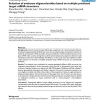Free Online Productivity Tools
i2Speak
i2Symbol
i2OCR
iTex2Img
iWeb2Print
iWeb2Shot
i2Type
iPdf2Split
iPdf2Merge
i2Bopomofo
i2Arabic
i2Style
i2Image
i2PDF
iLatex2Rtf
Sci2ools
BMCBI
2006
2006
Selection of antisense oligonucleotides based on multiple predicted target mRNA structures
Background: Local structures of target mRNAs play a significant role in determining the efficacies of antisense oligonucleotides (ODNs), but some structure-based target site selection methods are limited by uncertainties in RNA secondary structure prediction. If all the predicted structures of a given mRNA within a certain energy limit could be used simultaneously, target site selection would obviously be improved in both reliability and efficiency. In this study, some key problems in ODN target selection on the basis of multiple predicted target mRNA structures are systematically discussed. Results: Two methods were considered for merging topologically different RNA structures into integrated representations. Several parameters were derived to characterize local target site structures. Statistical analysis on a dataset with 448 ODNs against 28 different mRNAs revealed 9 features quantitatively associated with efficacy. Features of structural consistency seemed to be more highly corre...
| Added | 10 Dec 2010 |
| Updated | 10 Dec 2010 |
| Type | Journal |
| Year | 2006 |
| Where | BMCBI |
| Authors | Xiaochen Bo, Shaoke Lou, Daochun Sun, Wenjie Shu, Jing Yang, Shengqi Wang |
Comments (0)

